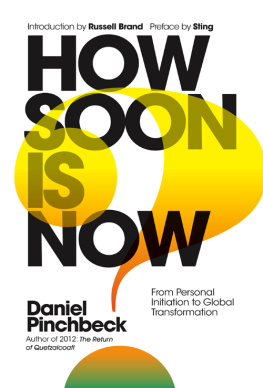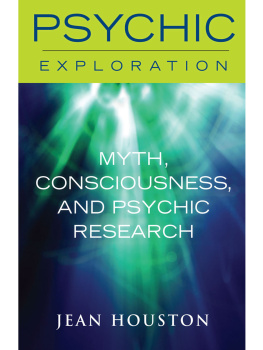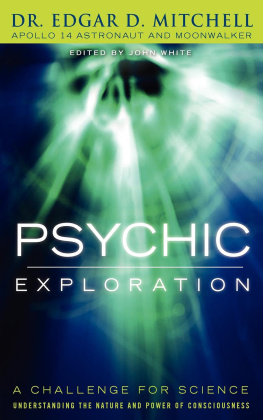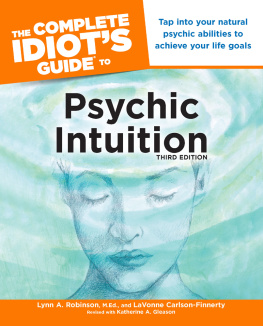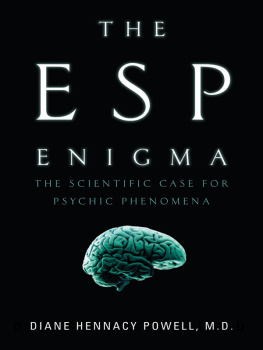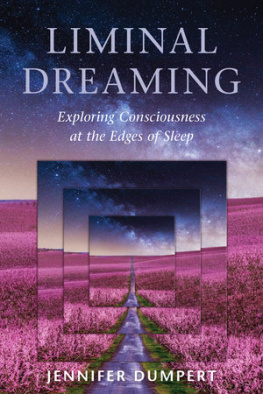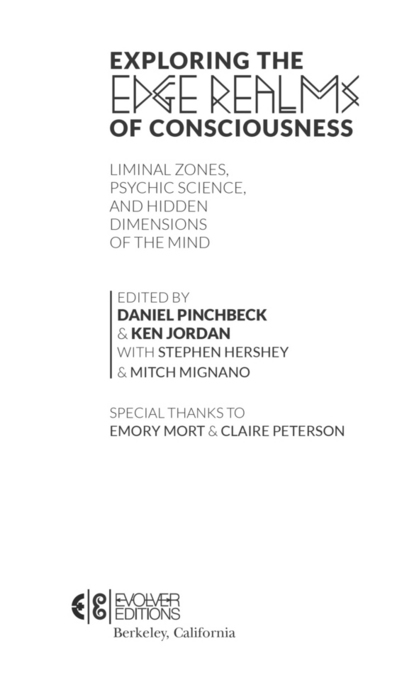Copyright 2012 by Daniel Pinchbeck and Ken Jordan. All rights reserved. No portion of this book, except for brief review, may be reproduced, stored in a retrieval system, or transmitted in any form or by any meanselectronic, mechanical, photocopying, recording, or otherwisewithout written permission of the publisher. For information contact EVOLVER EDITIONS c/o North Atlantic Books.
Published by EVOLVER EDITIONS, an imprint of North Atlantic Books
P.O. Box 12327
Berkeley, California 94712
Art direction and cover design by michaelrobinsonnyc.com
Exploring the Edge Realms of Consciousness: Liminal Zones, Psychic Science, and Hidden Dimensions of the Mind is sponsored by the Society for the Study of Native Arts and Sciences, a nonprofit educational corporation whose goals are to develop an educational and cross-cultural perspective linking various scientific, social, and artistic fields; to nurture a holistic view of arts, sciences, humanities, and healing; and to publish and distribute literature on the relationship of mind, body, and nature.
North Atlantic Books publications are available through most bookstores. For further information, visit our website at www.northatlanticbooks.com or call 800-733-3000.
Rights and permissions information can be found on .
Library of Congress Cataloging-in-Publication Data
Exploring the edge realms of consciousness : liminal zones, psychic science, and the hidden dimensions of the mind / edited by Daniel Pinchbeck and Ken Jordan with Stephen Hershey & Mitch Mignano.
p. cm.
eISBN: 978-1-58394-517-9
1. Parapsychology. 2. ConsciousnessMiscellanea. 3. Occultism. I. Pinchbeck, Daniel. II. Jordan, Ken.
BF1040.E97 2012
130dc23
2012013290
v3.1
CONTENTS
Exploring the Edge Realms of Consciousness: An Introduction
Daniel Pinchbeck
1. Syllable and Sound
Michael Taussig
2. Into the Quantum Realm
James Oroc
3. Divine Mothership of Trance: Boom 2010
Graham St John
4. Seeing into the Unseen: A Personal Journey of Discovery
Timothy Wyllie
5. Do You See What I See? Memoirs of a Blind Biker
Russell Targ
6. The Jhanas: Or, When Every Mystical State Youve Ever Wanted Isnt Enough
Jay Michaelson
7. Diamond Solitaire: Washing Beets with God
Erik Davis
8. On Anthropological Approaches to Anomalous Phenomena: Explorations in the Science of Magic and the Narrative Structure of Paranormal Experiences
David Metcalfe
9. Psiverts and Psychic Piracy: The Future of Parapsychology?
David Luke
10. What Gorilla? Why Some Cant See Psychic Phenomena
Dean Radin
11. Eye Spirits: Visions of the Blind
Paul Devereux
12. Meeting in the Dream World: Oneironauticum
Jennifer Dumpert
13. Lucid Dreaming
Paul Levy
14. Shattering Subconscious Isolation: Inception, Lucid Dreaming and the Collective Unconscious
Robert Waggoner
15. Layers of Illusion: Manifesting Astral Body, Dream, and Lucidity
Anthony Peake
16. Sleep Paralysis Visions: Demons, Succubi, and the Archetypal Mind
Ryan Hurd
17. Universal Feedback and Reality as Remix
Jennifer Palmer
18. Chaos, Synchronicity, and the Technology of Magic
Tony Vigorito
19. Synchronicity and Emergent Self-Organization
Simon G. Powell
20. Homo Luminous: The New Human
Alberto Villoldo
21. Journey Through a Cosmic Portal: A Serpent Ladder
Franklin LaVoie
22. Into the Green Underworld
Daenin Tejeda
23. Prolegomena to a Guide for the Emerging Yoga Shaman
Allowah
24. Super Free Will: Metaprogramming and the Quantum Observer
Paul Hughes
25. The Virtues of Being an Object: Touch, Pornography, and Having Bodies
Conner Habib
26. Virtual Reality and Hallucination
Diana Reed Slattery
27. Does Consciousness Depend on the Brain?
Chris Carter
EXPLORING THE EDGE REALMS OF CONSCIOUSNESS: AN INTRODUCTION
DANIEL PINCHBECK
I first had the idea for this book a number of years ago after watching a long, abstract, three-panel film by the legendary artist Harry Smith. Smith was an unclassifiable genius who understood that novelty and creative breakthroughs tend to occur in those in-between or liminal zones that most people are incapable of noticingin the blind spots of our ordinary perception. A connoisseur of sound who put together the Anthology of American Folk Music, a three-record set of obscurities that had a major influence on the folk revival of the early 1960s, Smith would go to jazz concerts with his tape recorder and microphone and meander into odd corners or hunch under the piano, seeking to catch muffled echoes or reverberations of notes that interested him more than the concert itself. The films he made are invitations for the mind to unbind from linear narrative or common sense, to find meditative repose in an incessant swarm of visual imageryto find electrical pulses of insight through being cut loose, unmoored, from ordinary constraints and the accretion of habit.
After the screening, my friend Spiros said he thought Smiths work explored what happens when the center and the periphery switch places. Watching his films, what we normally consider to be of central importancenarrative, plot, characterrecedes into nonexistence, so that other thoughts, ideas usually suppressed, can emerge in the interstices. This idea that the center and the periphery switch places is also a way to consider the prophetic transition of consciousness and civilization that many indigenous cultures and mystical traditions believe is upon usa transition I explored in my book 2012: The Return of Quetzalcoatl. Over the last centuries, modern civilization put what is material and quantifiable at the center of its concerns, and suppressed and marginalized the validity of subjective perception, the unique experience of the individual, along with the subtler domains and hidden dimensions of consciousness that archaic and ancient cultures understood as most essential, despite their quicksilver evanescence.
The most interesting phenomena take place at the edgesat the furthest periphery of what is known and understood, where signal meets noise and chaos entangles order. Take, for instance, the quantum world, with its eccentric quarks and muons, where those misbehaving energy clusters we call particles jump around and in between those other constructs of language and math we call dimensions of space and time. Similarly, when we consider the economic structure of capitalism, what is most interesting is not what economists report about linear development or factory production, but what occurs at the boundaries and farthest edges of the system, where ancient cultures find ways to transmute themselves and persist; where artists, deviants, and outlaws adapt and improvise in order to maintain their individuality within a seemingly totalizing and spirit-crushing machine.
Just as every belief system and ideology is ultimately a cult, every state of consciousness is, in essence, a kind of trance. Capitalism, for instance, is a materialist cult, and its worshippers are believers in a technological progress that has no connection to a natural world or an ensouled cosmos. The normative consciousness of a worker within our capitalist society is awake to the daylight world of work and responsibility, political maneuvering and financial calculation, but unaware of the deep reaches of the shamans night, where jaguars and snakes, demons and spirits battle for primacy, where awe, ecstasy, and terror mingle inextricably. Modern society forfeited vast arenas of vision, intuition, and supersensible perception in its fixation on what can be separated, defined, and controlled.


